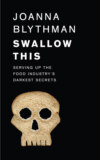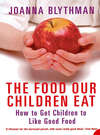Kitabı oku: «Swallow This: Serving Up the Food Industry’s Darkest Secrets»

Copyright
First published in Great Britain by Fourth Estate 2015
An imprint of HarperCollinsPublishers
1 London Bridge Street
London SE1 9GF
FIRST EDITION
Text © Joanna Blythman 2015
Original lettuce photograph © Shutterstock
Joanna Blythman asserts the moral right to
be identified as the author of this work
A catalogue record for this book is
available from the British Library
All rights reserved under International and Pan-American Copyright Conventions. By payment of the required fees, you have been granted the non-exclusive, non-transferable right to access and read the text of this e-book on screen. No part of this text may be reproduced, transmitted, downloaded, decompiled, reverse engineered, or stored in or introduced into any information storage retrieval system, in any form or by any means, whether electronic or mechanical, now known or hereinafter invented, without the express written permission of HarperCollins e-books.
Find out about HarperCollins and the environment at
Source ISBN: 9780007548330
Ebook Edition © JANUARY 2015 ISBN: 9780007548347
Version: 2015-12-04
Dedication
In memory of Derek Cooper,
a fellow foot soldier in the food wars.
Contents
Cover
Title page
Copyright
Dedication
Introduction
PART ONE: How the processed food system works
1 Why it all tastes the same
2 On the factory floor
3 Clean label
4 At the food makers’ market
5 Fresh in store
PART TWO: The defining characteristics of processed food
6 Sweet
7 Oily
8 Flavoured
9 Coloured
10 Watery
11 Starchy
12 Tricky
13 Old
14 Packed
Postscript
Notes
Index
Acknowledgements
By the same author
About the publisher
Introduction
Journalists don’t like to be palmed off with half the story, but even though I had 25 years of food chain investigations under my belt, six books to my name, and a collection of awards and gongs on my trophy shelf, I had a sneaking suspicion that this was exactly what was happening. Unanswered, or only partially answered, questions about the food we consume each day nagged away at the back of my mind. How ‘natural’ is the process for making a ‘natural’ flavouring? What, exactly, is modified starch, and why is this ingredient in so many foods? What is done to pitta bread to make it stay ‘fresh’ for six months? Why, when I eat a supermarket salad, does the taste linger in my mouth for several hours after? Slowly but surely, I realised just how little information about food production methods is in the public realm, despite the best efforts of those of us who interrogate the inner workings of the industry.
Now this assessment might seem counterintuitive, after all, you would be right in thinking that food exposés are a staple ingredient in news headlines. The media attention lavished on food fraud in particular is not inconsiderable. Thanks to such revelations, we know, for example, that crooks have illegally fed a stream of horsemeat into some of our most popular processed meats. We suspect, with some justification, that such incidents are only the tip of an iceberg.
But my frustration, my sense of not quite getting to the bottom of the story, was more fundamental. Forget illegal activities in the food chain, what about the perfectly legal activities that go on every day behind the scenes? What do we know about them? I’m not talking about primary food producers, farmers and growers; what happens down on the farm and out in the fields. This link in our food chain is passably well policed and transparent. Nor am I talking about the abattoir where, once again, there are regular inspections, even the occasional undercover reporter from a vigilant animal welfare group, armed with a video camera. No, my growing preoccupation was just how pathetically little we really knew about processed food, the food that sits on supermarket shelves in boxes, cartons and bottles, everything that comes wrapped or packed in some way, food that has had something done to it to make it more convenient and ready-to-eat.
My interest was in not just the most clearly processed, most industrialised offerings, things like ready meals, chicken nuggets, oven chips and tinned soups, but also those that less obviously bear the stamp of the food factory: washed salads, smoothies, yogurt, cheese, cereal bars, butchered meat, fresh fish, bread, fruit juice, prepared vegetables, and so on. Many switched-on consumers try to avoid the former, but you would need to be a desert island hermit to steer clear of the latter.
Slowly but surely, factory-made food has come to occupy an ever more bloated position in our diet. You might find it all too easy to resist the lure of a turkey drummer, a ready meal, a lurid fruit ‘drink’, or a pappy loaf of standard white bread. You might even boycott the most obvious forms of nutritionally compromised, blatantly degraded offerings, and yet you will still find it hard to avoid the 6,000 food additives – flavourings, glazing agents, improvers, anti-caking agents, solvents, preservatives, colourings, acids, emulsifiers, releasing agents, antioxidants, thickeners, bleaching agents, sweeteners, chelators – and the undisclosed ‘processing aids’, that are routinely employed behind the scenes of contemporary food manufacture. That upmarket cured ham and salami, that ‘artisan’ sourdough loaf, that seemingly authentic Levantine halva, that ‘traditional’ extra mature, vintage Cheddar cheese, those supposedly health-promoting, rustic-looking breakfast cereals, those luxurious Belgian chocolates, those speciality coffees and miraculous probiotic drinks, those virginal yogurts that seem as pure as driven snow, those apparently inoffensive bottles of cooking oil, and much, much more may all have had a more intimate relationship with state-of-the-art food manufacture technology than we appreciate.
The curious thing about processed foods, be they of the crude type or the more sophisticated sort, is that their mode of production is an enigma. Of course, anything that comes in a box, tin, bag, carton or bottle has to bear a label listing its contents, and many of us have become experts at reading these labels to avoid ingredients with unnatural-sounding chemical connotations. But guess what? Many of the additives and ingredients that once jumped out at us from labels as flagging up something fake and unfathomable have quietly disappeared from listings.
Does this mean that their contents have improved? Possibly, but there is an alternative explanation. Over the last few years, many food companies have embarked on an operation dubbed ‘clean label’, with the goal of removing the most glaring industrial ingredients and additives from labels, replacing them with substitutes that sound altogether more benign. Many of the factory-made, processed foods on our shelves have discreetly undergone a before-and-after makeover, and many have also been relabelled with confidence-inducing buzzwords such as ‘antioxidant’, ‘gluten-free’, ‘whole grain’, ‘more of’, ‘less’ of, ‘high in’, ‘low in’, ‘reduced sugar’, etc., which psychologically prime us to infer that they bring an overall health benefit to our tables. It all comes together to make a seemingly informative chorus.
But when you try to dig deeper, as I wanted to do, to go beyond the label, you hit a wall of secrecy. How is a ready-to-eat cottage pie actually made? Why is there high fructose corn syrup in your steak and ale pie? How are zero-calorie sweeteners created? What makes those cherries in your fruit cake stay firm? Why are those peppers so shiny? Why would you need beef protein in a pork sausage? Expect to draw a blank.
Back in the days when food writers were stereotyped by processed food manufacturers and retailers as fluffy-headed scribes who could be enlisted to help sell their products, several big food companies opened their doors to them. They were given a selectively edited diplomatic tour of the processing facility, spending most of the visit well away from the din and distress of the factory floor in the relative calm of the development kitchen. Here they were expected to ooh and ah about the latest prepared dish soon to be shipped out to stores around the land, then write about it enthusiastically in magazines and supplements. Celebrity chefs ‘consultants’ were paid handsomely to lend their seal of approval to products churned out by industrial food companies, sprinkling on them the stardust that surrounds this much-admired profession.
This romancing of the food media stuttered to a halt when reservations about industrial food production practices reached critical mass and food scandals started to feature in news pages. In 1990, for instance, the Norfolk turkey king, Bernard Matthews, abruptly terminated a face-to-face interview with me in his office when I put to him questions about mechanically recovered meat, and asked to be shown round one of his windowless poultry sheds.
For at least the last decade, the big manufacturing companies that turn ingredients into products have kept a low profile. They take refuge in health and safety rules; factories are dangerous places after all. And they hide behind the creed of commercial confidentiality. We can’t let our competitors know what’s in our secret recipe, now can we? Fair enough, but also a perfect way to stonewall citizens who want to know just a little bit more about the genesis of their pulled pork pizza or their microwaveable veg pot.
Nowadays, manufacturers leave it to retailers to field any searching questions. Retailers in turn take shelter behind the will-sapping, call-centre pointlessness of the customer care line. Here the tactic is to drown callers in superfluous, mainly irrelevant material (long lists of allergens, calorie counts and so on) without answering any tricky questions. The most persistent enquirers may be treated to an edit-to-suit, off-the-peg customer reply letter from corporate HQ containing a bland, non-specific reassurance, such as: ‘Every ingredient in this product conforms to quality assurance standards, EU regulations, additional protocols based on the tightest international requirements, and our own demanding specification standards … blah de blah.’ Basically, thank you and goodbye.
Few journalists nowadays bother approaching the press offices of our large food retailers and manufacturers unless they have a very specific, narrow query, such as ‘Do you sell skipjack tuna caught in purse seine nets?’ Any broader enquiry is likely to be met with a cloud of words more insubstantial than a breakfast waffle. Even then, they do not expect a prompt or particularly illuminating response. Relatively junior press office staff will log and note the query, and if it sounds potentially troublesome, pass it upstairs to their superiors. In this case, corporate affairs executives will be on the job, framing a carefully worded response, which, when you pare it down, discloses the barest possible substantive fact.
And if the truth were told, few people outside the world of food processing, journalists or otherwise, are in a position to pose pertinent questions anyway. You need to understand a bit about a subject in order to know what questions to ask, and the increasingly complex technologies used in contemporary food manufacturing are shrouded in mystery to all but industry initiates.
So I set out to put in the public domain more information about the mechanics of how factory food is made. Where to begin? By guaranteeing that the visits would be for background only, I managed to see inside some of the more open-minded manufacturing facilities, which was illuminating up to a point, except that these plants are so thoroughly industrial, that it was not easy to interpret what I was seeing, or work out which bits of the production process I wasn’t being shown.
As far as general research went, using all the resources the internet has to offer, materially enlightening information was equally hard to come by. All the companies that supply ingredients to the food and drink manufacturing arena have a public or media website, accessible to anyone who bothers to look. These typically consist of a mixture of old press releases, business statistics – how many people we employ in how many countries, and so on – and Frequently Asked Questions. These public sites are conspicuously devoid of tangible facts. Their creators have clearly mastered the art of saying nothing much, at great length. All are designed to cast the company’s activities in a flattering light.
Then there are separate sites, or subscriber-only areas of company sites, that share product knowledge and developments amongst industry insiders. These facilitate a deeper level of dialogue that is internal to the food manufacturing business; the trade talking to the trade. In particular, they allow the chemical industry to tell food manufacturers how our food can be shaped, engineered and redesigned. They offer practical case studies of how innovative modern ingredients, such as enzymes, nanoparticles, protein isolates, acidulants, permeates, cyclodextrins and sugar alcohols can revolutionise production, and offer technical ‘solutions’ to commonly encountered problems. Even then, when it comes to the nitty-gritty of what an ingredient, additive or process actually involves or does in a specific food or drink context, manufacturers are almost invariably urged to contact the company direct to discover what technical ‘applications’ the product in question might have for their business.
Such sites are very definitely do-not-disturb zones for industry outsiders. In fact, you need to pass through various hurdles to be allowed into the club. For instance, when I tried to subscribe to Innovadex, formerly known as Chemidex, the biggest online ingredient search engine for food and drink manufacturers, I received the following reply:
Thank you for completing your registration with Innovadex. Access is not immediate and is dependent upon approval. Notification of your access will be sent within one business day. Innovadex.com is an internet-based resource designed specifically for use by chemists and formulators. Membership is restricted to validated institutional users of product information who are involved in the purchase and use of raw materials and ingredients.
Needless to say, my Innovadex subscription was not forthcoming, and it was the same story with the registered users-only sites of companies supplying our food manufacturers. Here you have to fill in a series of subscription application questions to establish your suitability. What is the name of your company? What is your company website? What sector are you in (meat, dairy, bakery, etc.)? Are you a manufacturer or retailer? What is your position and job title in the company (product developer, buyer, processor, etc.)? How many employees do you employ? What band does your annual turnover fall into? What school did you last attend? I’m joking about this last one, but unless you fit searching criteria, your subscription application goes no further.
What about dropping in on some of the global summits where food manufacturers network with ‘visionary researchers’, ‘thought leaders’ and ‘horizon scanners’ from leading ingredient suppliers? The same restrictions apply. You must be an approved industry insider of the vetted sort, and even if you are, the fee for attendance is pitched at a level (several hundreds, sometimes thousands of pounds) that only deep corporate pockets can contemplate. In food manufacturing, no one seems to blink at stumping up £1,999 for a conference pass, or paying £399 upwards for a workshop; and that’s before VAT.
Just supposing you were enough of an anorak to want to read and digest meaty technical documents that would help cast light on what goes on behind the scenes of food manufacturing, you would have to pay handsomely for the privilege. For instance, a publication, such as ‘Food Flavours & Flavour Enhancers: Market, Technical & Regulatory Insights’, published by market researchers, Mintel, and Leatherhead Food Research, a leading food and drink industry research and development body, might fill us in on how these additives are used, and give us a steer on how much of them we all consume. But at £2,600 plus VAT, just like a Rolex, that’s a rather exclusive purchase. In many different ways, food manufacturers and the global ingredients companies that supply them, operate a very effective apartheid system that bars anyone who doesn’t belong. Glasnost is not a core operating principle of the factory food industry.
Fortunately for consumers, the food and drink industry is not a monolith, and not all companies believe that the public is best left in the dark. A couple of them very kindly provided me with a ‘cover’ that allowed me to pass through the security vetting and gain unprecedented access to material that has not previously been in the public realm. They helped me get closer to the beating heart of modern factory food production. This book is all about what I found there, and even to me, as a seasoned food journalist, it was an eye-opener.
In the first part, I have tried to set the scene of how the world of food and drink manufacturing operates, from the factory floor, to the supermarket sales floor, and at a cutting edge industry event. In the second part, I have laid out before you what, after all my research, I now consider to be the defining characteristics of this industry’s products: food and drink that is sweet, oily, old, flavoured, coloured, watery, starchy, tricky and packed. Where possible, I have allowed the industry to speak for itself. Quotes are revealing. When a company offers manufacturers ‘customised masking solutions for tastes you want to hide’, or promises shelf life extension products that give foods a ‘fresh-like’ quality for several weeks, this gives you a clue to some of this industry’s paramount concerns.
In as much as we are encouraged to think about the nitty-gritty of manufacturing, that is, not at all, we are led to believe that what goes on in food factories is essentially the same as home cooking, only scaled-up. Any such perception is self-serving, coy and to my mind, misleading. What you might see, after dipping into this book, is how radically different food manufacturing is in its concepts, goals, behaviours and ethos from any form of domestic food preparation. Unlike home cooks, food manufacturers are driven by innovation and novelty. They work not from a framework of time-honoured principles, but with a blank sheet. Each new product is, in industry-speak, a ‘matrix’, a never-ending jigsaw puzzle of possible elements, either chiselled out from natural ingredients, or entirely man-made, that can be arranged and rearranged, right down to the molecular level if necessary, then stuck together in various ways, and in numerous forms, to meet certain overriding goals. For product developers and food technologists, the professionals who design and create a never-ending stream of products, whole, raw, unprocessed foods present a shopping trolley of components to play around with.
So when the home cook decides to make a Bakewell tart, for instance, she or he looks out a recipe, puts together a line-up of well-established ingredients – raspberry jam, flour, butter, whole eggs, almonds, butter and sugar – and then bakes it in a tried-and-tested way. The factory food technologist, on the other hand, approaches this venerable confection from a totally different angle. What alternative ingredients can we use to create a Bakewell tart-style product, while replacing or reducing expensive ingredients – those costly nuts, butter and berries? How can we cut the amount of butter, yet boost that buttery flavour, while disguising the addition of cheaper fats with an inferior taste profile? What sweeteners can we add to lower the tart’s blatant sugar content and justify a ‘reduced calorie’ label? How many times can we re-use the pastry left over from each production run in subsequent ones? What antioxidants could we throw into the mix to prolong the tart’s shelf life? Which enzyme would keep the almond sponge layer moist for longer? Might we use a long-life raspberry purée and gel mixture instead of conventional jam? What about coating the almond sponge layer with an invisible edible film that would keep the almonds crunchy for weeks? Could we substitute some starch for a proportion of the flour to give a more voluminously risen result? Would powdered, rather than pasteurised liquid egg, stick less to the equipment on the production line? Could we use a modified protein to do away with the eggs altogether, or to mimic fat? And so on.
According to the Food and Drink Federation, a body that promotes the interests of companies active in the field, food and drink manufacturing is ‘a great British success story’. Thanks to the steady stream of pre-prepared, convenience food it puts on our plates, the average proportion of household income spent on food has dropped from 50 per cent in 1914 to around 10 per cent in 2014. In fact, the UK now spends less on food than any country in the world, bar the USA.
We have been striding purposefully down this Anglo-American food path for decades. George Orwell clocked the trend back in 1937 in his book, The Road to Wigan Pier. ‘The English palate, especially the working-class palate, now rejects good food almost automatically. The number of people who prefer tinned peas and tinned fish to real peas and real fish must be increasing every year’, he wrote. He noted that in England at that time, a man over six feet was usually ‘skin and bone and not much else’, attributing this largely to ‘the modern industrial technique which provides you with cheap substitutes for everything’. He warned in no uncertain terms where the move away from home-cooked, real food might lead us: ‘We may find in the long run that tinned food is a deadlier weapon than the machine gun’.
How prescient Orwell was. Nowadays, the expression of our ongoing embrace of factory food in its myriad processed forms is rather different than in the 1930s, with an irony that would not be lost on him. A growing number of us are simultaneously overfed and undernourished, a crazy consequence of our reliance on food manufactured in an industrial setting. Whereas Orwell linked processed food consumption with excessive skinniness, today’s six-foot-tall man, like most other citizens, will most likely be carrying a good few kilos of excess weight. These days, a disturbing 60 per cent of the UK population is overweight; a quarter of us are obese.
Are we leaping to an unjustified conclusion when we lay a significant part of the blame for obesity, chronic disease and the dramatic rise in reported food allergies, at the door of processed food? There are several a priori grounds for seriously examining this possibility. Firstly, food manufacturers combine ingredients that do not occur in natural food, notably the trilogy of sugar, processed fat and salt, in their most quickly digested, highly refined, nutrient-depleted forms. Might these modern constructions be addictive? That proposition is gaining airtime. Secondly, manufactured foods often contain chemicals with known toxic properties – although we are reassured that at low levels, this is not a cause for concern. Thirdly, the processed food industry has an ignoble history of actively defending its use of controversial ingredients, such as partially hydrogenated oils, long after well-documented, subsequently validated, suspicions have been aired.
The precautionary principle doesn’t seem to figure prominently in the convenience food industry’s calculations, and such is the lobbying power of this influential sector, it does not loom large in the deliberations of our would-be regulators either. If it did, then steering clear of manufactured products that are very likely to prejudice your health would be a lot easier. All through this book, you will read examples of potentially harmful ingredients and processes being used in food and drink manufacturing, yet statutory bodies fail to restrict them because they do not yet have full, incontestable certainty of damage.
I would like to be able to report that the powers-that-be are working away in the best interests of the population to curb the processed food industry’s worst excesses. I would be delighted if the concerns I raise in this book could be swept away by strategic government action: better labelling, taxes on miscreant foods, and tighter industry surveillance. But I believe that hell will freeze over before the state takes radical action to protect us from the damage caused by processed food. Why? This industry is just so damn profitable.
The bottom line here is that there are already reasonable grounds to infer that a diet heavy in processed food is bad for us. We can wait for that contention to be ‘proven’, and the activities of the companies that sell unhealthy food to be restricted, or we can start operating our own personal precautionary principle by eating less of it, and cooking more of our own food from scratch.
This is not to say that there is no such thing as a healthy, wholesome manufactured food. I happily use many processed ingredients. Realistically, I am not likely to keep a house cow for milk, or make my own butter and cheese. Nor do I intend to grow my own grain and mill it into flour; although I know some inspiring people who do, and very much admire their commitment. I am a purchaser of bread, not a baker. I might, in a flush of enthusiasm for a new recipe, make some egg pasta from scratch, but usually, I’ll buy it in a packet. I don’t lie awake at night worrying about what effect canning might have on my anchovies or pilchards. I often grind my spices for a special dish because they are fresher and more aromatic that way, but pre-ground spices also sit usefully in my larder alongside other processed foods such as tomato paste, soy sauce, sesame oil, rosewater, olives, gherkins, oatcakes, mustard. When my mother no longer has any of her homemade marmalade or jam to give me, I’ll gladly buy some. My salads contain seeds that have been sprouted by someone other than me. Although I am intellectually enthused by the fashion for fermentation, I remain a more likely candidate for buying sauerkraut than making it. While I fully appreciate that it is possible to cure your own bacon, I’m just too lazy to try it.
In short, I have absolutely no intention of becoming a food neurotic, or living in splendid isolation as a Trappist monk. Like most of us, I am not always in control of what I eat, so I have to settle for the best option in the circumstances. Sometimes, I might be organised enough to bring my own food on a long journey, knowing that in quality terms, it will be streets ahead of anything I can buy, not to mention cheaper. But other times I still have to pick up lunch from a takeaway, trust my local delicatessen to make a reasonable quiche or sandwich, or politely eat a meal that I would never choose. I am also a restaurant critic, reviewing everything from chains to fine dining establishments on a weekly basis. Doing this job would be impossible if I was a purist, someone who took the attitude that my body is a temple that can never be sullied by processed food in any shape or form. I do not beat myself up if I can’t meet my highest aspirations for eating good food on a daily basis. I am a pragmatist. Food is my love, not my enemy. I will not allow my professional knowledge of how it is produced to spoil my appetite for it.
Yet what I choose to eat and drink starts from the over-arching principle that natural ingredients in their least processed forms have an inbuilt, effortless integrity that make them the best basis for a body and soul-sustaining life. Natural foods are brilliantly conceived and intricate little packages wherein every nutrient works in a companionable ‘one for all, and all for one’ synergy. When we prepare and eat natural foods, their wise completeness translates into palpable health benefits. Nutritionally speaking, the whole apple does much more for us than the apple juice, or the apple crumble, or the apple and oat breakfast bar, or the apple-flavoured gum, and it’s hard to overeat whole apples. Manufactured foods, by contrast, are put together by people who, although indisputably smart and capable, do not have Nature’s all-embracing, all-seeing intelligence. This is why so many of the products manufacturers create share the capacity to shorten our lifespans.
I honestly didn’t set out to put you off eating anything that comes in a bottle, jar, packet, tin, tube, carton or polystyrene container, but when you read about certain practices and procedures used to make some of our most popular foods, this might somewhat dull your appetite for a few products. My message is not the comfortable one that the UK Department of Health wants to convey with its ‘eatwell plate’, which conspicuously promotes many popular processed foods and drinks – sweets, biscuits, cake, cornflakes, baked beans, flavoured yoghurts, sliced white bread, even a can of cola, and crisps – as part of a ‘balanced diet’. Nor are the sentiments that run through this book in tune with the ‘Don’t Cook, Just Eat!’ campaign so loudly promoted by purveyors of fast food, with eye-grabbing posters in the windows of takeaways up and down the land. Their self-styled ‘anti-cooking manifesto’ urges us to ‘liberate’ ourselves from its ‘tyranny’ by letting ‘professionals do the work’.















